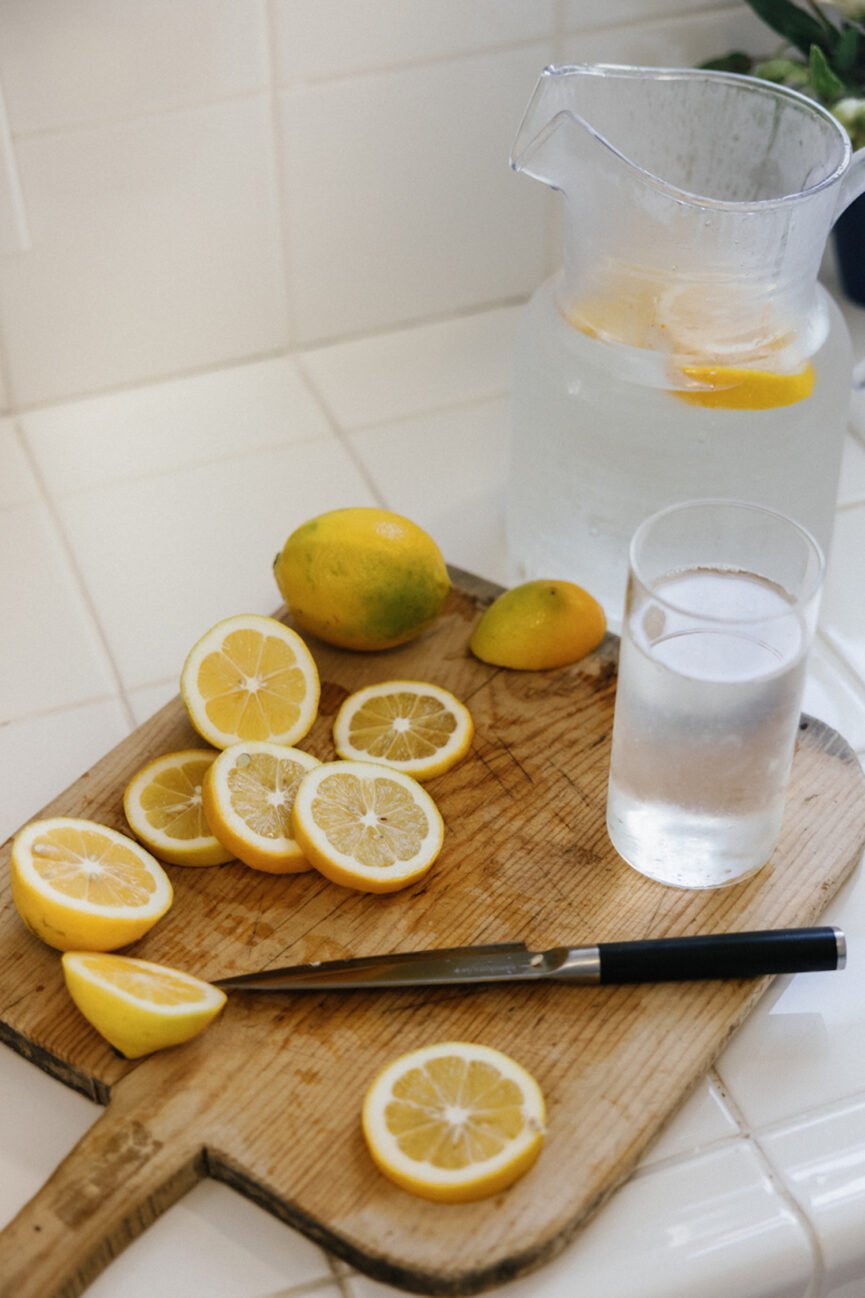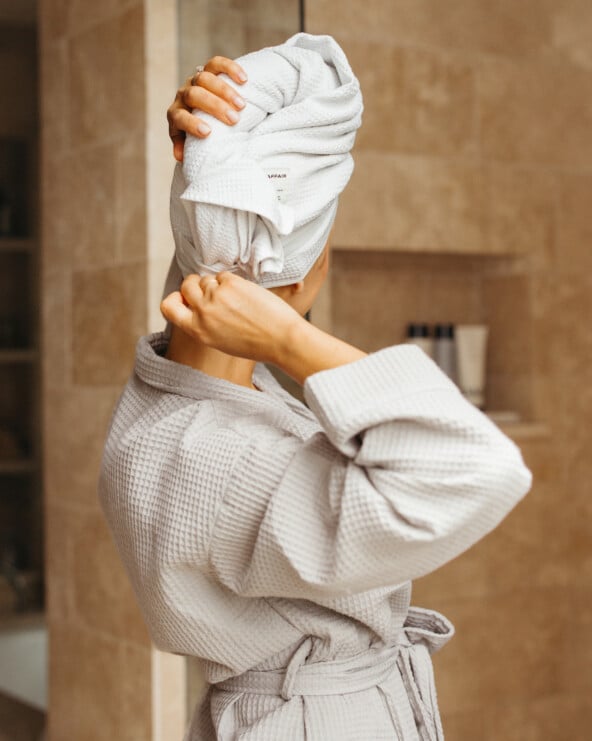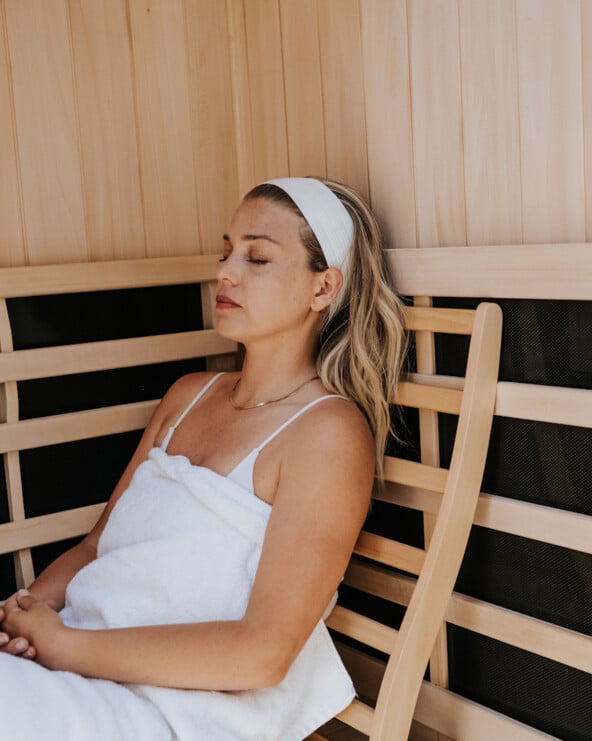If your social media feeds look anything like mine, you might have noticed a surge in posts about cosmetic acupuncture. While it might sound like the latest trend in the ever-evolving world of beauty, this practice has deep roots in ancient Chinese medicine. But what exactly is cosmetic acupuncture, and why is it making waves in the skincare world today? Spoiler alert: It’s not just about chasing the fountain of youth—there’s a lot more beneath the surface.
To get the lowdown on this blend of beauty and wellness, we sat down with Brooke Taylor. Previously an esthetician and global skincare educator, Brooke now owns and operates The Road in Austin—one of our favorite spots for holistic beauty treatments and thoughtfully sourced wellness goods. Taylor’s work is redefining how we think about skincare—moving away from quick fixes and toward a more integrated approach that nurtures the body and mind. Because it’s not just about looking our best (though that’s certainly a perk). Beauty is more so about fostering a sense of well-being that radiates from within.
Featured image from our interview with Laura Lee.

Brooke created The Road in Austin, Texas to share her experience in holistic skincare, acupuncture and Chinese medicine to nurture our own innate healing responses. Previously an esthetician and global skincare educator and brand manager, she pursued her masters in Chinese medicine to help heal others on a deeper level. She now incorporates cosmetic acupuncture and Chinese medicine, facial sculpting techniques, curated skincare, and high tech modalities to guide clients on their journey to looking and feeling their best, holistically.
What is cosmetic acupuncture?
Taylor emphasizes that this practice goes beyond topical treatments. “We don’t treat the face in a microcosm; we consider how your whole health is playing into its condition and appearance, and then we treat accordingly,” Taylor explains. This holistic approach, rooted in Traditional Chinese Medicine (TCM), recognizes the interconnectedness of all body systems, meaning that facial rejuvenation is about more than just beauty—it’s about overall well-being.
“We start by providing acupuncture for the body, followed by specialized tiny needles strategically placed on the face,” she says. Taylor notes that these treatments are designed to address fine lines, wrinkles, collagen production, and a range of skin concerns like acne and rosacea. Her expertise also includes advanced techniques such as fascia work, lymphatic drainage, gua sha, and light therapy, all combined with carefully curated skincare. This comprehensive approach not only enhances the skin’s appearance but also contributes to stress relief, hormonal balance, and health.
Short-Term Benefits of Cosmetic Acupuncture
“Short-term benefits are a reset for the skin and body/mind,” Taylor says, describing how this treatment can bring a noticeable return to a more youthful face posture. The results are more than skin-deep, with clients often experiencing a significant reduction in fine lines and wrinkles, along with a boost in skin nourishment and hydration.
This quick refresh is part of what makes cosmetic acupuncture so appealing. The immediate glow and sense of renewal are just the beginning, setting the stage for long-term benefits that continue to unfold with ongoing treatment.
Long-Term Benefits of Cosmetic Acupuncture
“Long term, we build on these results, creating more resilient, healthy skin and microbiome,” Taylor explains. With regular maintenance, clients often experience profound changes, noticing that they don’t exhibit the same signs of aging as their peers.
Of course, consistency plays a crucial role in these lasting results. Taylor notes that those who commit to ongoing sessions not only maintain youthful, vibrant skin but also support their health as a whole. It’s this holistic approach that sets cosmetic acupuncture apart, offering a powerful combination of aesthetic and health benefits that endure over time.


Is there a role for injections in facial maintenance? Can cosmetic acupuncture replace them?
While cosmetic acupuncture may not fully replace procedures like facelifts, it plays a crucial role in enhancing and maintaining skin health. Taylor observes that many patients are now seeking alternatives to fillers, particularly as more conservative approaches gain traction in the aesthetics world.
“Injectors are saying filler isn’t useful for ‘lift,’ so exploring alternatives like face yoga, lymphatic massage, or gua sha can be more beneficial,” Taylor advises. Cosmetic acupuncture not only addresses the physical aspects of aging but also tackles underlying issues like stress and hormonal imbalances, offering a more comprehensive path to facial rejuvenation.
What’s more, Taylor suggests that cosmetic acupuncture helps extend the time between injections and can even reduce the need for them altogether. While it’s not a substitute for invasive interventions, this practice offers a natural, health-focused route to achieving vibrant, youthful skin.
“Most of my patients find that our treatments help them go much longer between injections, keeping the muscles toned and the skin healthy,” Taylor explains.
For those committed to a more holistic approach to skincare, cosmetic acupuncture provides a effective alternative that promotes well-being while enhancing facial aesthetics.


What misconceptions about cosmetic acupuncture do you frequently encounter with your clients?
When it comes to cosmetic acupuncture, many might assume the focus is solely on the face. However, as Taylor emphasizes, that couldn’t be further from the truth. “Your face and skin are part of a head-to-toe connected system,” Taylor explains, meaning that treatments often go beyond facial acupuncture to address root causes.
From hip tightness to stress levels, every aspect of your body can influence your skin’s health and appearance. Taylor’s approach is centered on the concept of Qi, the flow of energy through the body. “For optimal health and skin, we look for the flow of energy—any stagnation can lead to issues like pigmentation or redness,” she notes.
Taylor’s practice doesn’t stop at acupuncture. If underlying issues like poor digestion or extreme fatigue are affecting a patient’s skin, she works with a team of specialists to address these concerns at their source. This comprehensive care ensures that skin treatments are more effective and long-lasting. “Outcomes for the face happen much more rapidly by treating the whole [body],” Taylor advises. This underscores the importance of understanding how interconnected our bodies truly are, and how a well-rounded treatment plan can lead to healthier, more vibrant skin.


What skin maintenance mistakes do you commonly see in your practice?
1. Small Tweaks Snowball Into a Series of Fixes
One of the most common pitfalls Taylor sees in her cosmetic acupuncture practice is the tendency for a small tweak to snowball into a series of ‘fixes’—and not always for the better.
“Over-filling the cheeks, for instance, might cause more wrinkles in the under-eye area, leading to a need for Botox,” she explains.
This cycle of chasing corrections can result in a less natural appearance and a reliance on multiple interventions. Taylor’s approach, in contrast, is about addressing underlying issues rather than quick fixes.
2. Using Too Many Harsh Ingredients That Aren’t Suited for Your Skin
Another mistake Taylor frequently encounters is the overuse of potent skincare ingredients, especially among younger clients. “Using too many high-octane actives or harsh ingredients not suited for their skin can lead to inflammaging,” she warns. This can cause redness, dehydration, and premature aging.
3. Not Paying Attention to Root Causes
Finally, Taylor stresses the importance of correctly identifying the causes of your facial concerns. A ‘double chin,’ for example, might be the result of tight neck muscles or poor tongue posture. “We can often resolve neck lines by sorting out posture issues, rather than resorting to invasive procedures,” Taylor advises.


What do people subconsciously see when they look at our facial skin/structure?
While we may fixate on fine lines and wrinkles as signs of aging, others aren’t necessarily attuned to these details. “What people actually notice is the clarity of the skin,” Taylor explains. This clarity, rather than a perfectly smooth surface, conveys a sense of vitality and overall health. Social media may have perpetuated the ideal of a flawless face, but the reality is that a vibrant, healthy complexion—marked by the natural glow of well-cared-for skin—communicates youthfulness more effectively.
Achieving this isn’t about erasing every blemish or spot. “It’s more about the total health of the skin and the ‘shen’—the vitality that shines through the eyes,” Taylor notes. Her insights point to this truth: Beauty comes from nurturing the skin’s health and embracing a natural radiance, rather than striving for an unattainable perfection.
In general, how should we approach improving our facial appearance?
Taylor advocates a holistic approach grounded in the principles of acupuncture. “Acupuncture helps manage the tenets of ‘adulting’—sleep, digestion, stress, emotions, and hormones,” she explains. This doesn’t just target the surface. Instead, it addresses the underlying factors that influence skin health. By balancing these core aspects of daily life, acupuncture supports the skin’s natural rejuvenation process, reflecting a more vibrant and healthy appearance.
“The key is consistency,” Taylor emphasizes. Rather than a quick fix, this approach encourages a steady and adaptive response to life’s challenges, ensuring that both your overall health and skin remain in optimal condition. By committing to this holistic strategy, you’re not just improving your appearance but fostering a more balanced and resilient state of being.






